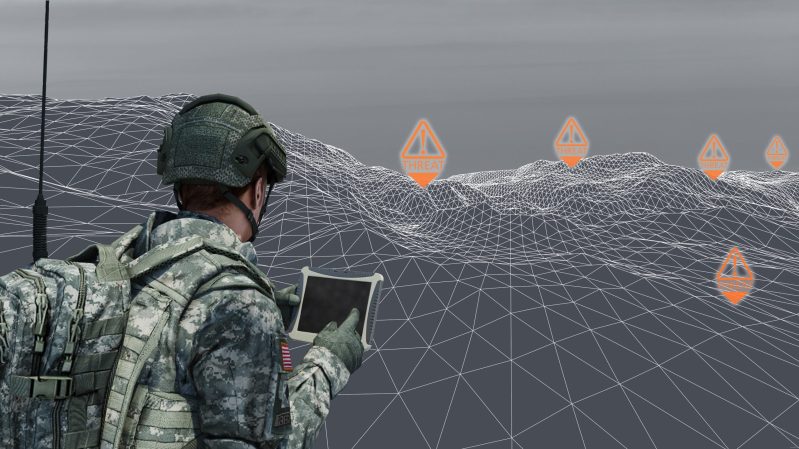

When Russian forces occupied Ukraine’s Crimean peninsula in February 2014, the Russian Navy reportedly jammed cell phone signals in the process. This kind of attack, paired with the physical destruction of communications infrastructure, as well as online attacks on internet-connected sites and services, is broadly categorized as electronic warfare.
War is still primarily an undertaking involving bombs, bullets, and broken bodies, but the placement of those bombs and bullets is increasingly shaped by fights waged in the electromagnetic spectrum. Electromagnetic warfare is often paired with attacks on computer systems carried out over the internet, which are broadly called cyber attacks.
Understanding how modern wars are fought means understanding the invisible fights waged by signals and over code.
If Russia does launch an attack on Ukraine, as the mass of Russian forces that have been assembled for months along their shared border suggest it might do, electronic warfare will likely be part of the attack, as it was when Russia occupied parts of Ukraine in 2014. The 2014 occupation included the Russian capture of Crimea, complete with physical destruction of communication links to the rest of the country, and led to Russian support for two self-declared breakaway republics of separatists in Eastern Ukraine.
[Related: The tanks, rockets, and other weapons that Russia has in its arsenal]
That bloody war is still ongoing, though now it takes place against the backdrop of at least 140,000 Russian forces bordering Ukraine. Should that shooting war between Ukraine and the separatists escalate into a ground war and possible Russian invasion, it will likely start with artillery fire and electronic warfare. The impact of explosives will be visible. The invisible war over signals will be much harder to immediately perceive, but no less a part of the conflict. Here’s what to know about the basics of electronic warfare.
What is electronic warfare?
The Department of Defense defines Electronic Warfare as “military activities that use electromagnetic energy to control the electromagnetic spectrum (‘the spectrum’) and attack an enemy.” The spectrum encompasses everything from radio waves through visible light to gamma rays.
How old is electronic warfare?
One way to understand warfare in the electromagnetic spectrum is to go back to its early use in World War II. Radar, a new sensor at the start of the war, works by sending out a radio wave and then interpreting the way that beam gets reflected back towards the sensor that sent it. One of the earliest radar countermeasures, also in World War II, was chaff, or reflective metal strips that would distort any radar beam they hit, masking the presence of planes behind the chaff.
[Related: Russia is building a tank that can pick its own targets. What could go wrong?]
In the Vietnam War, both sides used multiple kinds of sensor and signal interference, obstructing not just the movements of planes but the guidance of anti-plane missiles. Chaff, which jams by physical properties, remains a tool to counter electronic detection, and it has been joined by others, like sending out targeted signals on the electromagnetic spectrum that frustrate sensors such as radar. Jammers often draw on a lot of power to specifically jam other sensors, which can limit the range or duration of jamming, but it can still make the difference between a plane being seen and shot by enemies, or the plane sneaking through to get a first strike.
What makes electronic warfare so important in modern conflicts?
While radar debuted in World War II, much of combat was still fought within visual range, with pilots and soldiers alike trusting their eyes first to spot any enemies, or relying on map coordinates recorded by observers. Now, the increased range of weapons and the proliferation of sensors means everything from tanks to artillery to aircraft rely on sensors detecting signals in the electromagnetic spectrum.
Jan Kallberg, a scientist at the Army Cyber Institute, puts it bluntly: “Every modern high tech weapon system is a dud without access to spectrum.”
For example, GPS signals, which are vital for many vehicles to know where they are, are radio signals. A radio-emitter that can block a drone from receiving those signals can prevent drones from flying. Russia’s truck-mounted Krasukha-4 system is a system that has been shown to jam drones at range in Syria. Other nations have demonstrated jammers that work at some range, like the MRZR LMADIS tested by the US Marine Corps in 2019.
What about cyber?
While electronic warfare encompasses a spectrum of activities, the Department of Defense treats attacks on computers over the internet differently. The Department defines “cyberspace” as “a global domain” that includes “the internet, telecommunications networks, computer systems, and embedded processors and controllers.”
Or, more plainly, the connection between computers, networks, and the tools to use them is seen by the Pentagon as a place where war can happen. Sometimes, these attacks can take place through the electromagnetic spectrum in which a signal is used to inject code into an enemy’s computer. More often, these attacks travel over the existing infrastructure of the internet.
Defining “cyberwar” is a tricky topic, as it can be hard to draw the lines between what is espionage, what is sabotage, what is fighting, and especially, between what counts as civilian or military targets.
The Ukrainian Defense Ministry has already reported major cyber attacks on its infrastructure this week. If Russia does launch an invasion of the country, it is likely that cyber attacks and electronic warfare would play a role in the conflict, alongside more visible weapons like artillery and tanks.






















